
About Andrew Cusack
 Writer, web designer, etc.; born in New York; educated in Argentina, Scotland, and South Africa; now based in London.
Writer, web designer, etc.; born in New York; educated in Argentina, Scotland, and South Africa; now based in London. read more
News
Blogs
Reviews & Periodicals
Arts & Design
World
France
Mitteleuropa
Knickerbockers
Argentina
The Levant
Africa
Cape of Good Hope
Netherlands
Scandinavia
Québec
India
Muscovy
Germany
Academica
The Rhodes Memorial
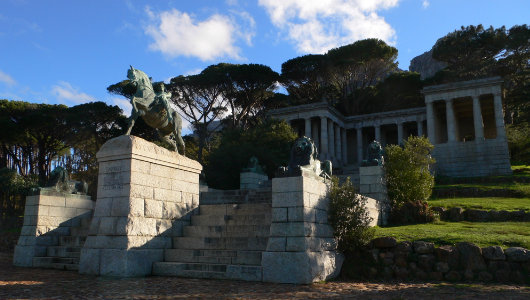
PERCHED AMID THE bluegum trees on the slopes of Devil’s Peak in Cape Town is the memorial to one of the most brilliant & cunning men the world has ever produced. Cecil John Rhodes may have been born in Bishop’s Stortford, England, but his worldly glories all emanated from the Cape of Good Hope, and so it’s appropriate that his memorial stands here in Cape Town. His first commercial enterprise in South Africa was founding the Rhodes Fruit Farms (now Rhodes Food Group) which still exist on the road from Stellenbosch to Franschhoek, and has since expanded throughout the Western Cape, and to the Transvaal and Swaziland. But it was his creation of the diamond monopoly De Beers out of the Kimberley mines that made him one of the wealthiest men in the world. Ten years after being elected to the Cape Parliament, he was made Prime Minister of the Cape in 1890, but his catastrophic and illegal attempt to seize the independent Transvaal in 1895 forced his resignation from politics in disgrace.
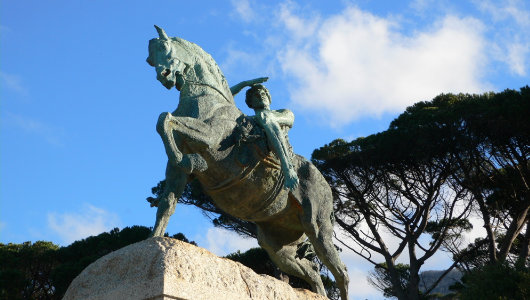
Such a terse summary of Rhodes’s life is obviously lacking. The country he founded through a chartered private company, Rhodesia, now exists only in the memories of those who lived there until its final transformation into Zimbabwe in 1980. In the northern hemisphere, he is most recalled for endowing the Rhodes Scholarships which enable carefully selected university students from the former British Empire and from Germany to pursue postgraduate studies at Oxford. His will also enabled the establishment of Rhodes University in Grahamstown, Eastern Cape, one of the premier English-language universities in South Africa. On a whim, he commissioned a whole trove of untranslated ancient Greek texts to be translated into English for the first time.
Rhodes was an evil man, or at the very least a man not devoted to good. But despite his obvious flaws, he was much admired in his day and afterwards. Mark Twain, presuming Rhodes would meet his end with a hangman’s noose, declared: “I admire him, I frankly confess it; and when his time comes I shall buy a piece of the rope for a keepsake”.
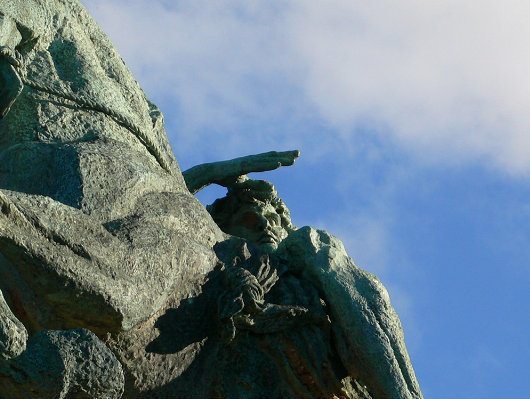
Rhodes surely must rank in the “top ten” of people who have thousands of things named after them, alongside Alexander, Victoria, Lenin, Washington, and others. The historian Richard Wood wrote of a white boy growing up in Rhodesia:
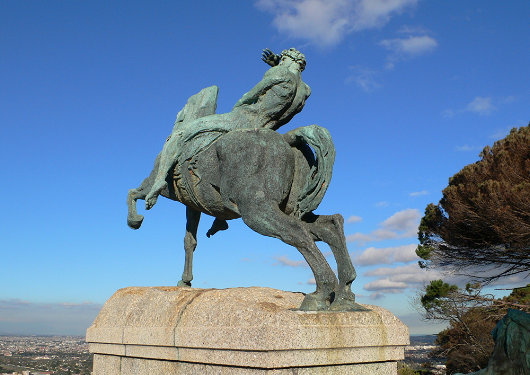
Rhodes is memorialised not only in Rhodesia. Oxford boasts the Rhodes Scholarships, Rhodes House (headquarters of the Rhodes Trust), the Rhodes Professorship, the Rhodes Memorial Lecture, and Oriel College at Oxford boasts a Rhodes Building with a statue of the eponymous patron. “High up on the front of the Rhodes Building,” notes the historian Paul Maylam (of, appropriately, Rhodes University), “is a statue of Rhodes; beneath his feet are statues of two lesser mortals, King Edward VII and King George V.”
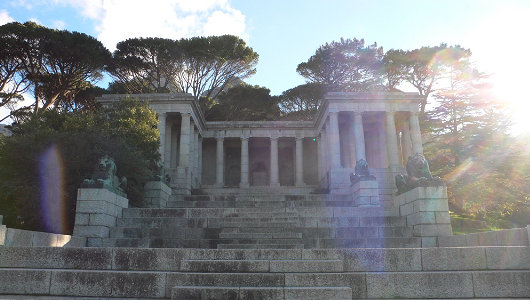
In Cape Town, a famous statue of Cecil Rhodes sits in the Company’s Gardens in the middle of the city, and walking down from there to Adderley Street one comes across the Rhodes Building (subject of an upcoming post on this site), now incorporated into the Mandela-Rhodes Place development. At the University of Cape Town, itself endowed by Rhodes, there is another statue of the man, and from the University one takes Rhodes Avenue until there is a turn-off for the Rhodes Memorial.
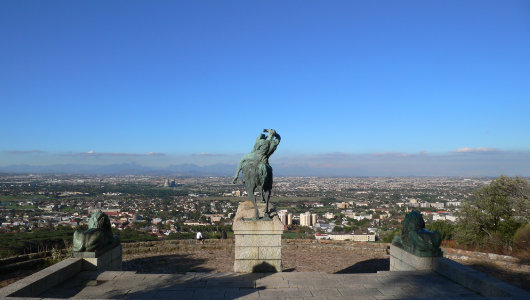
The location was actually one of Rhodes’ favourite vistas on his Groote Schuur estate, looking out northwards over the Cape Flats towards, beyond the horizon, the Rhodesia that bore his name. The bronze equestrian statue “Physical Energy” is by the symbolist sculptor George Frederic Watts.
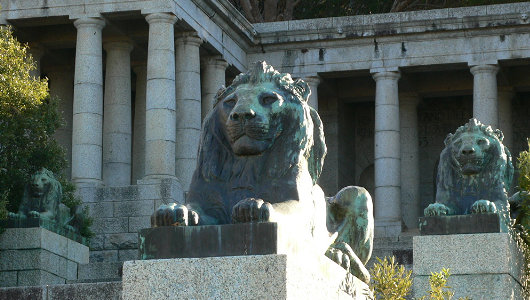
Eight lions by John Macallan Swan flank the forty-nine massive steps, one for each of Rhodes’ forty-nine years of life.
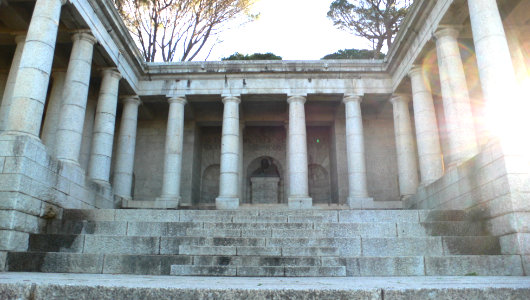
The great steps were built out of Cape granite quarried from Table Mountain itself, and rise to the columned temple at the top. Designed by Sir Herbert Baker, the Rhodes Memorial is modelled on the ancient Greek temple at Segesta, even though it is closer to that of Pergamon in its actual design.
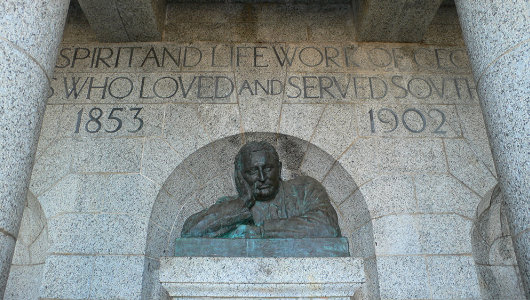
Inside, a statue of the brooding, dreaming Rhodes, with the inscription “To the spirit and life work of Cecil John Rhodes who loved and served South Africa”. A stanza from Kipling’s “Burial” — the poet’s 1902 funerary ode to his friend Cecil Rhodes — is also inscribed here.
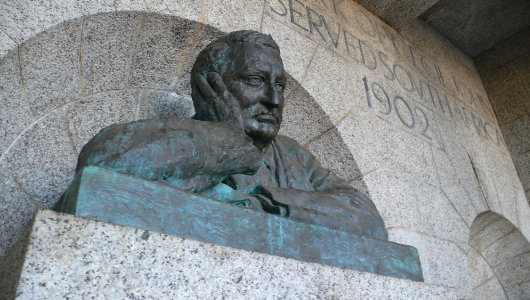
Rhodes is not buried here but at the Matopo Hills in Zimbabwe. After his death, Rhodes lay in state first at Groote Schuur, the magnificent Cape Dutch house he had built to Sir Herbert Baker’s designs, and then in the Cape House of Assembly. Following that, there were no less than four funeral services: one at Groote Schuur, one at St. George’s Cathedral, one in Bulawayo, and a final one at his resting place at the Matopos, on the same day that a memorial service was taking place at St. Paul’s Cathedral in London. His interment was attended by the chiefs & indunas of the Matabele tribe he had conquered, who requested that the firing party not discharge their rifles as it would disturb the great spirit. Then, for the only time ever given to a white man, they rendered the Matabele royal salute, “Bayete”.
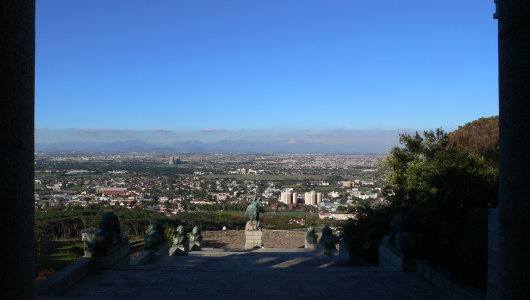
The original proposal for a Rhodes Memorial, made by Earl Grey, was for a massive statue of Rhodes akin to the Statue of Liberty to be erected at the summit of Signal Hill overlooking Cape Town and the harbour. This suitably pagan proposal is hubristically comparable to Christ the Redeemer overlooking Rio de Janeiro — “an extraordinary landmark,” Maylam calls the Earl’s proposal, “a monstrosity, indelibly stamped on the beautiful city skyline”. I think we can all breath a sigh of relief that Sir Herbert Baker’s monument was built instead.
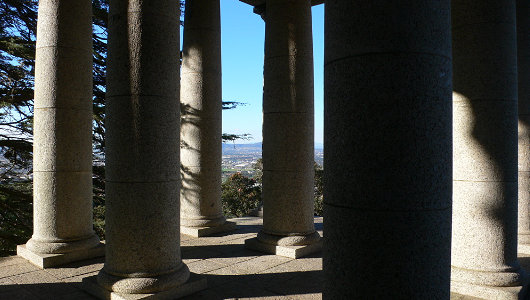
“In the overall design,” Maylam continues, “Baker aimed to express both thought, embodied in the contemplative pose of the bust, and action, manifested in Watts’ statue. The lions were designed to express ‘qualities of calm and reserved strength and power’. As a tribute to Rhodes, the Memorial was skillfully conceived. It reflected both Rhodes’ liking for classical architecture and his feeling for Table Mountain. Rhodes would have been delighted with the Memorial. It would surely have satisfied his yearning for immortality. Its prominent site and high visibility gives Rhodes an enormous, looming presence over Cape Town.”
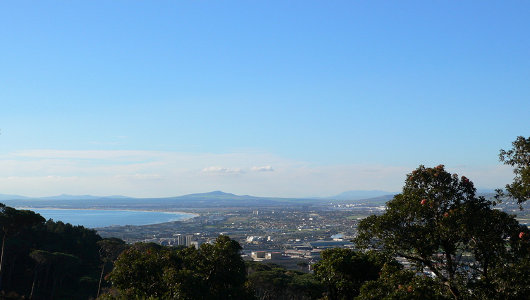
The monument was completed in 1912, ten years after the death of ‘The Colossus’, and quickly became a place where visitors came to pay their respects to this giant of Africa. It is still well-visited today, though not in tribute to Rhodes as much to enjoy the beautiful view, and to sample the excellent melktart served in the tea room discretely nestled beside the Memorial.
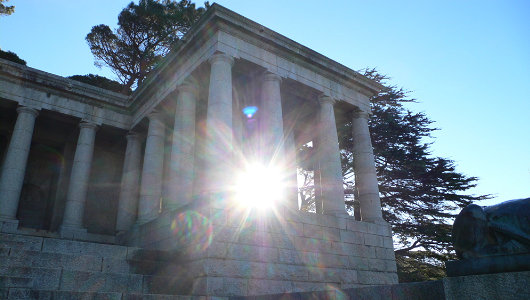
Search
Instagram: @andcusack
Click here for my Instagram photos.Most Recent Posts
- Gellner’s Prague December 19, 2024
- Monsieur Bayrou December 18, 2024
- Dempsey Heiner, Art Critic December 17, 2024
- Vote AR December 16, 2024
- Articles of Note: 12 December 2024 December 12, 2024
Most Recent Comments
Book Wishlist
Monthly Archives
Categories



“an evil man”? Ridiculous.
Rather a great one, who nevertheless, like us all, bore the wounds of the Fall.
maybe not evil.but surely self obsessed and self worshipping.
Cecil John Rhodes a truely great man,and the founder of Rhodesia.Unlike the tyrant ruling Zimbabwe just now,who is murdering his own people just to stay in power.